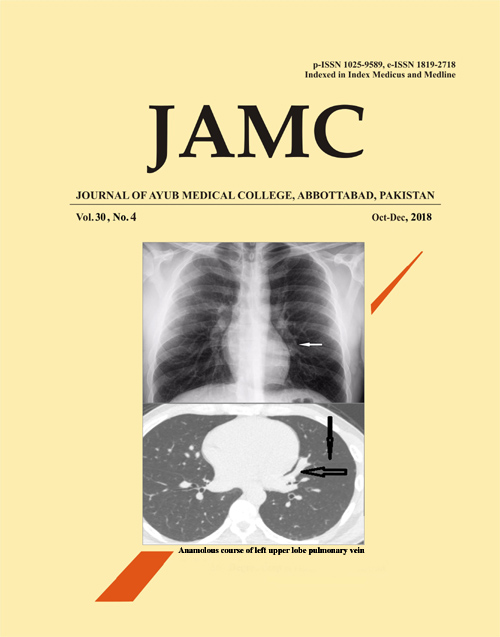VISUAL AND MICROSCOPIC EVALUATION OF THE SURFACE ALTERATIONS IN THE PROTAPER FILES AFTER SINGLE CLINICAL USE
Abstract
Background: Different studies have been conducted in which defects of Ni-Ti files were reported after multiple usages but limited data is available regarding the defects in the rotary Ni-Ti files subjected to single clinical use. The objective of this study was to determine the frequency of surface defects caused by fatigue in the rotary ProTaper files after single clinical use assessed with visual and microscopic examination methods. Methods: A cross-sectional study was conducted in the dental clinics of The Aga Khan University Hospital, Karachi, Pakistan. A total of 189 ProTaper Ni-Ti files (after single clinical use in multi-rooted molars) were analysed visually and then under stereomicroscope at 10Χ magnification for surface defects (straightening, denting, bending, twisting, pitting and change in length). Chi Square test was used to determine association between type of file and type of defect. Spearman's correlation test was used for determination of correlation between visual and microscopic examinations at 0.05 level of significance. Results: 19% of files showed straightening on visual assessment as compared to 66.1% under microscopic examination. There was a statistically significant association between the file type and the straightening of file (p value ‰¤0.001). A weak correlation existed between visual and microscopic examination for all the defects, except for the change in length. Conclusions: The defects of ProTapers files are best detected by the microscopic examination. Straightening is the most common defect observed visually and microscopically. The first shaping and first finishing files underwent significantly more surface defects than the rest of the rotary files in the series.
Keywords: Defects; Evaluation; Instrumentation; Root canal; Root canal therapy
References
Shen Y, Zhou HM, Zheng YF, Peng B, Haapasalo M. Current challenges and concepts of the thermomechanical treatment of nickel-titanium instruments. J Endod 2013;39(2):163-72.
Alapati SB, Brantley WA, Svec TA, Powers JM, Nusstein JM, Daehn GS. SEM observations of nickel-titanium rotary endodontic instruments that fractured during clinical use. J Endod 2005;31(1):40-3.
Bergmans L, Van Cleynenbreugel J, Wevers M, Lambrechts P. Mechanical root canal preparation with NiTi rotary instruments: rationale, performance and safety. Am J Dent 2001;14(5):324-3.
Schrader C, Peters OA. Analysis of torque and force with differently tapered rotary endodontic instruments in vitro. J Endod 2005;31(2)120-3.
Parashos P, Messer HH. Rotary NiTi instrument fracture and its consequences. J Endod 2006;32(11):1031-43.
Asthana G, Kapadwala MI, Parmar GJ. Stereomicroscopic evaluation of defects caused by torsional fatigue in used hand and rotary nickel-titanium instruments. J Conserv Dent 2016;19(2):120-4.
Sattapan B, Nervo GJ, Palamara JE, Messer HH. Defects in rotary nickel-titanium files after clinical use. J Endod 2000;26(3)161-5.
Chakka NV, Ratnakar P, Das S, Bagchi A, Sudhir S, Anumula LD. NiTi instruments show defects before separation? Defects caused by torsional fatigue in hand and rotary nickel-titanium (NiTi) instruments which lead to failure during clinical use. J Contemp Dent Pract 2012;13(6):867-72.
Cheung GS, Bian Z, Shen Y, Peng B, Darvell BW. Comparison of defects in ProTaper hand-operated and engine-driven instruments after clinical use. Int Endo J 2007;40(3):169-78.
Shen Y, Coil JM, Mclean AG, Hemerling DL, Haapasalo M. Defects in nickel-titanium instruments after clinical use. Part 5: single use from endodontic specialty practices. J Endod 2009;35(10):1363-7.
Patiño PV, Biedma BM, Liébana CR, Cantatore G, Bahillo JG. The influence of a manual glide path on the separation rate of NiTi rotary instruments. J Endod 2005;31(2):114-6.
Iqbal MK, Kohli MR, Kim JS. A retrospective clinical study of incidence of root canal instrument separation in an endodontics graduate program: a PennEndo database study. J Endod 2006;32(11):1048-52.
Parashos P, Gordon I, Messer HH. Factors influencing defects of rotary nickel-titanium endodontic instruments after clinical use. J Endod 2004;30(10):722-5.
Nagi SE, Khan FR, Rahman M. Comparison of fracture and deformation in rotary endodontic files: Protapers versus K-3 systems. J Pak Med Assoc 2016;66(10):S30-2.
Farid H, Khan FR, Rahman M. Pro-Taper Rotary instrument fracture during root canal preparation: A comparison between rotary and hybrid techniques. Oral Health Dent Manag 2013;12(1):50-5.
Arens FC, Hoen MM, Steiman HR, Dietz GC Jr. Evaluation of single-use rotary nickel-titanium instruments. J Endod 2003;29(10):664-6.
Wei X, Ling J, Jiang J, Huang X, Liu L. Modes of failure of ProTaper nickel-titanium rotary instruments after clinical use. J Endod 2007;33(3):276-9.
Downloads
Published
How to Cite
Issue
Section
License
Journal of Ayub Medical College, Abbottabad is an OPEN ACCESS JOURNAL which means that all content is FREELY available without charge to all users whether registered with the journal or not. The work published by J Ayub Med Coll Abbottabad is licensed and distributed under the creative commons License CC BY ND Attribution-NoDerivs. Material printed in this journal is OPEN to access, and are FREE for use in academic and research work with proper citation. J Ayub Med Coll Abbottabad accepts only original material for publication with the understanding that except for abstracts, no part of the data has been published or will be submitted for publication elsewhere before appearing in J Ayub Med Coll Abbottabad. The Editorial Board of J Ayub Med Coll Abbottabad makes every effort to ensure the accuracy and authenticity of material printed in J Ayub Med Coll Abbottabad. However, conclusions and statements expressed are views of the authors and do not reflect the opinion/policy of J Ayub Med Coll Abbottabad or the Editorial Board.
USERS are allowed to read, download, copy, distribute, print, search, or link to the full texts of the articles, or use them for any other lawful purpose, without asking prior permission from the publisher or the author. This is in accordance with the BOAI definition of open access.
AUTHORS retain the rights of free downloading/unlimited e-print of full text and sharing/disseminating the article without any restriction, by any means including twitter, scholarly collaboration networks such as ResearchGate, Academia.eu, and social media sites such as Twitter, LinkedIn, Google Scholar and any other professional or academic networking site.










